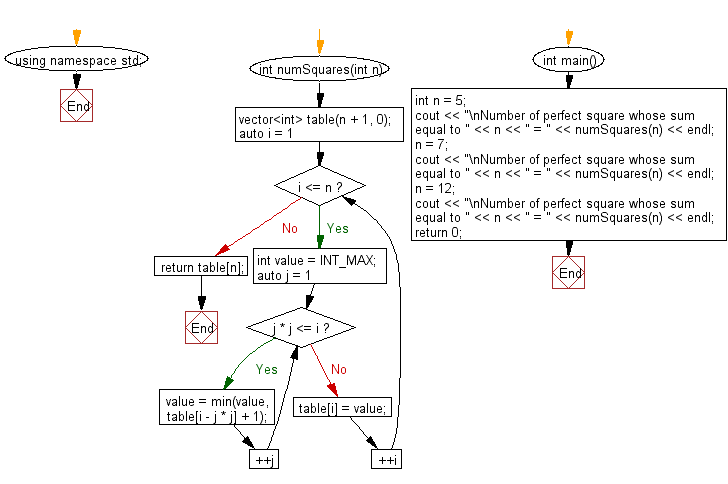C++ Exercises: Find the number of perfect square numbers which represent a sum of a given number
27. Count Perfect Squares Summing to a Given Number
Write a C++ program to find the number of perfect squares (e.g. 1, 4, 9, 16, ...) that represent the sum of a given number.
Sample Input: n = 5
Number of perfect square whose sum equal to 5 = 2
Sample Input: n = 7
Number of perfect square whose sum equal to 7 = 4
Sample Solution:
C++ Code :
#include <iostream>
#include <vector>
using namespace std;
// Function to find the minimum number of perfect square numbers that sum up to n
int numSquares(int n) {
// Create a vector 'table' of size (n + 1) initialized with 0
vector<int> table(n + 1, 0);
// Loop from 1 to n
for (auto i = 1; i <= n; ++i) {
int value = INT_MAX; // Initialize 'value' as the maximum integer value
// Loop through squares from 1 to sqrt(i)
for (auto j = 1; j * j <= i; ++j) {
// Update 'value' by finding the minimum among the current 'value' and
// the value at table[i - j * j] plus 1
value = min(value, table[i - j * j] + 1);
}
// Store the minimum number of perfect square numbers that sum up to 'i' in 'table'
table[i] = value;
}
return table[n]; // Return the minimum number of perfect square numbers that sum up to 'n'
}
int main() {
int n = 5; // (4 + 1)
cout << "\nNumber of perfect squares whose sum equals " << n << " = " << numSquares(n) << endl;
n = 7; // (4 + 1 + 1 + 1)
cout << "\nNumber of perfect squares whose sum equals " << n << " = " << numSquares(n) << endl;
n = 12; // (4 + 4 + 4)
cout << "\nNumber of perfect squares whose sum equals " << n << " = " << numSquares(n) << endl;
return 0;
}
Sample Output:
Number of perfect square whose sum equal to 5 = 2 Number of perfect square whose sum equal to 7 = 4 Number of perfect square whose sum equal to 12 = 3
Flowchart:

For more Practice: Solve these Related Problems:
- Write a C++ program to count the number of ways a given number can be expressed as the sum of perfect squares using recursion.
- Write a C++ program that finds the number of combinations of perfect squares that add up to a given number using dynamic programming.
- Write a C++ program to recursively determine the count of perfect square combinations that sum to a target value.
- Write a C++ program that calculates the number of ways to represent a number as the sum of perfect squares and prints the count.
Go to:
PREV : Find the Missing Number in a Sequence.
NEXT : Maximum Product from Breaking an Integer.
C++ Code Editor:
Contribute your code and comments through Disqus.
What is the difficulty level of this exercise?
